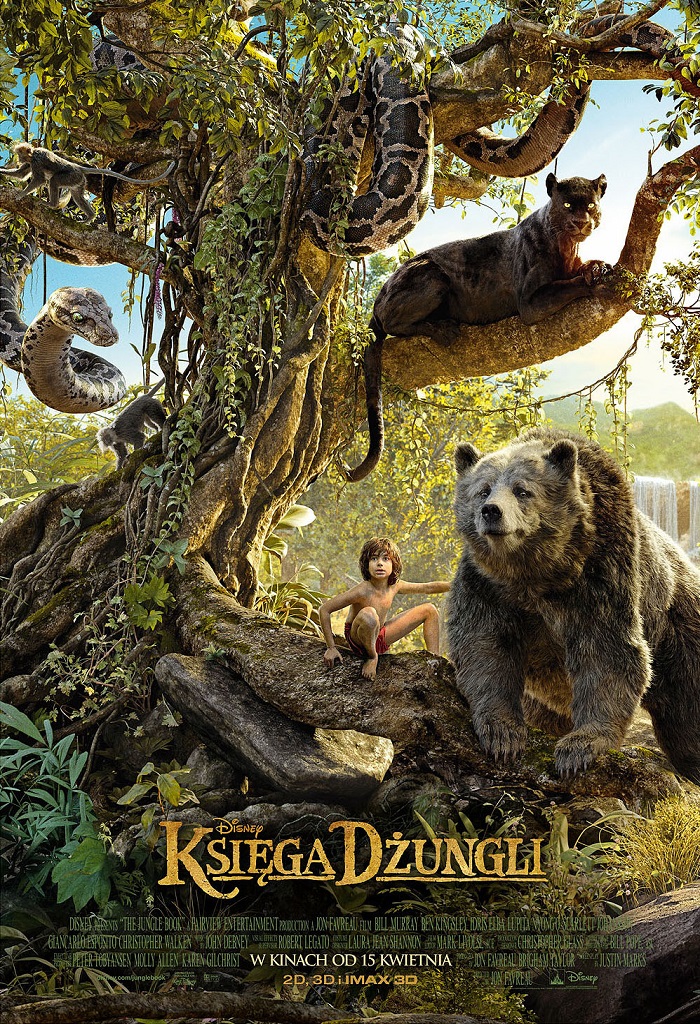The Jungle Book
Bartłomiej Stańczak
Student uczestniczący w kursie International Children’s Film
(pod kierunkiem dr hab. Justyny Deszcz-Tryhubczak)
It is rare enough for a remake of a popular and loved movie to do justice to the original work – or in this case – the original screen adaptation. The balancing act between pandering to the audience already familiar with the story and one that is uninitiated requires attention to detail and planning so careful that it can quickly outgrow even the capabilities of an experienced director. And yet, Jon Favreau and Justin Marks’ The Jungle Book strikes all the right nostalgia notes while managing to expand beyond what the first Disney production had achieved. The story is technically the same, but the feeling you get from the movie is anything but. If there is one word to describe this live-action remake in comparison to the original Walt Disney production – it is darker.
The plot of the movie follows a familiar route – Mowgli, the man-cub, is a parentless child adopted by a pack of wolves, living peacefully in the jungle. His relatively worry-free life changes dramatically when he is forced to leave the pack by demand of Shere Khan (Idris Elba) – a tiger, and main antagonist of the movie, who despises humans and threatens to kill the boy. Much of the story is focused around Mowgli’s journey to the human village deep in the jungle and the trouble and adventures he finds himself in. During his travel, the boy slowly discovers his origins, and what it means to be a man among nature.
What differs greatly from the original animation is not so much the story, although it is told in greater detail with several added scenes and different visualizations of moments familiar to the initiated audience. The real difference comes in the jungle ambiance. While there are times of joyous levity, a large portion of the story is notably gloomier. When Mowgli is accompanied by friends, the original childlike atmosphere is retained, even going as far as recreating some of the original songs like “The Bare Necessities” sung by Baloo (Bill Murray). However, when danger encroaches, for example when the boy is taken before King Louie (Christopher Walken), the song “I wanna be like You” takes on a more menacing approach which perfectly emphasizes Mowgli’s distress at being coerced into becoming an accomplice to the power-hungry monkey king. Darker still is the landscape as Mowgli’s journey unfolds. Favreau uses a dull color palette to accompany the man-cub once he gets lost in the deep recesses of the forest. Paired with a symphony of eerie, unsettling ambient sounds, ripped straight from a thriller, the jungle is truthfully creepy and no longer seems the same idyllic, safe place it was made out to be in the original animation. Similarly, the characters are more fleshed out and less childlike. The best example is Shere Khan himself, whose voice and actions feel much more threatening, and who does not hesitate from maiming or even killing. Another example is Kaa, whose character is wonderfully executed with Scarlet Johansson’s hypnotizing, smoky voice accentuating the many dangers of the jungle. What is perhaps most important is the fact that death is very much present, and when fights ensue, they feel real and reach far beyond the comedic relief of the first animation. Throughout most of the movie, Mowgli is covered in blood and mud, gaining new scratches and bite marks on the daily?. As for death, this is perhaps the most controversial part of the remake – some of the key figures actually die instead of being comically defeated and embarrassed.
In short, the 2016 Jungle Book is a remake that sees the cult classic in a far less dreamy, childish light, bringing it much closer to Rudyard Kipling’s stories than the first version ever did. The best way to describe this movie in relation to the original Disney production is that the 2016 version feels like an adult reinventing a childhood fantasy after having been exposed to the reality of life. However, the baseline movie is very similar in the way it conveys its predictable, didactic aspect. For this reason, I would certainly recommend it both for children who have never seen the original, as well as adults who want to see their favorite childhood story in a more mature light.

